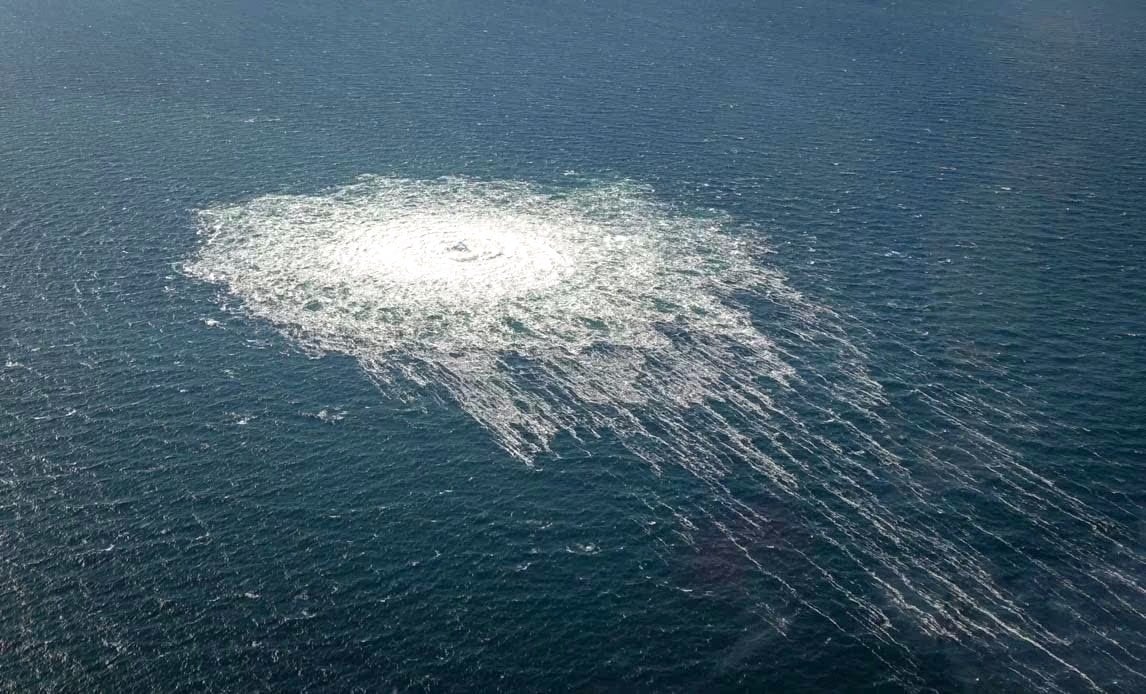
[ad_1]

Since 26 September, mysterious leaks have appeared in the underwater Nord Stream gas pipelines—which run from Russia to Germany—close to the Danish island of Bornholm in the Baltic Sea. Given the tense energy situation between Russia and the West following Russia’s invasion of Ukraine, a real-life geopolitical whodunit has ensued, with NATO now among those attributing the leaks to sabotage. Seismologists picked up data that might help to pinpoint the cause of the leaks, and other researchers are trying to work out how much methane—a potent greenhouse gas—will be released as a result.
Overnight on 26 September, the Nord Stream 2 pipeline’s operators saw a sudden pressure drop, from 105 bar (which is 105 times atmospheric pressure) to just 7 bar. Soon after, a 1-kilometre-wide area of the Baltic Sea’s surface was bubbling with the escaping gas.
The Nord Stream 2 pipeline has been shut since Russia invaded Ukraine in February, but it is still full of gas, which is assumed to be around 90% methane. The drop in pressure prompted seismologists to look more closely at their data, says Björn Lund at Uppsala University, Sweden. The attention on seismology data has made for an extraordinary week. “I’ve never experienced anything like it,” says Lund, adding that his network detected seismic activity at the same time as the leak that is consistent with explosions, not earthquakes—which have a different seismic fingerprint.
Climate alert
The events have also put the climate community on alert. When Andrew Baxter, once an engineer in the oil and gas industry, now the director of energy transition at the Environmental Defense Fund, based in New York City, heard about the leak in Nord Stream 2, he “switched back into engineering mode” to try to quantify the resulting methane release. “I came up with a very rough estimate, there are so many variables and unknowns here, it’s very difficult to definitively say how much methane has made it into the atmosphere,” he says.
Baxter estimated that 115,000 tonnes of methane had probably been released during the initial sudden pressure drop in Nord Stream 2, on the basis of the pipe’s dimensions and the water temperature. Per unit mass, methane has a much more potent greenhouse effect than carbon dioxide—particularly in the short term. Baxter says the overall impact of this leak is equivalent to the annual carbon emissions from two million cars.
“If these numbers end up being confirmed, it would be the one of the largest single leaks of natural gas in history in a single location,” says Zeke Hausfather, a climate scientist at Berkeley Earth, a data-analysis non-profit organization in California. But he adds that this doesn’t fundamentally change the magnitude of global emissions.
The event, although huge, accounts for around 0.14% of the global annual methane emissions from the oil and gas industry, says Mark Davis, chief executive of Capterio, a company in London that tracks gas flares from industry, but which didn’t detect the vented gas because it isn’t burning. He argues that, once the leak was discovered, setting it alight could have mitigated much of the damage, by converting the methane to carbon dioxide. Since the initial pressure drop in Nord Stream 2, leaks have also been reported in the Nord Stream 1 pipeline, which runs alongside it and is also currently not operational.
Satellite measurements
Measuring precisely how much methane has been emitted is going to take time. Efforts so far have been hampered by the quirks of geography and bad luck. The public satellites that environmental observations rely on were not facing the right way at the time, says Itziar Irakulis-Loitxate at Valencia Polytechnic University, Spain, who uses satellite data to measure atmospheric methane levels. And the cloud cover common at the northern latitudes meant that it was almost impossible to get any data. That is on top an inherent challenge in monitoring methane over water: water absorbs most of the sunlight and masks any signal from methane in a spectrometer.
The methane spike was detected from the ground by at least one observatory: the Swedish station of the European Integrated Carbon Observation System project at Hyltemossa.
In the coming days and weeks, scientists will continue to try to understand how much methane has been released as a result of the leaks. Seismologists might also be able to help to determine how the pipes were ruptured. By comparing the seismic data they collected on the Nord Stream explosions with that from previous naval blasts, Lund and his team already suspect TNT.
Lund and his colleagues are scrambling to work out from their seismic data exactly how many blasts occurred, but he notes that the complex geology of Earth’s crust in the region between Denmark and Sweden makes it hard. “There’s a very big change in the thickness of the crust of the rock material,” he says.
This article is reproduced with permission and was first published on September 30 2022.
[ad_2]